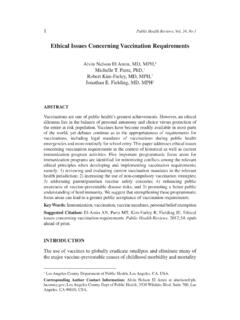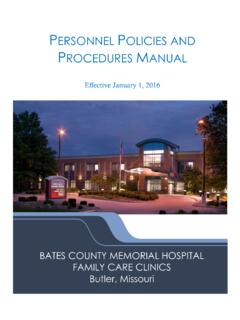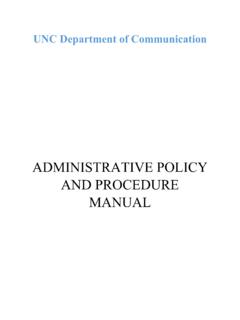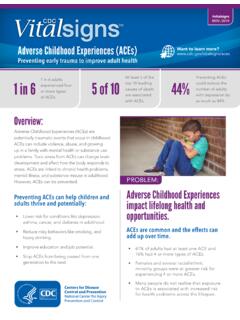Transcription of What is the “New Public Health”?
1 25 Public Health Reviews, Vol. 32, No 1, 25-53. What is the New Public Health ? Theodore H Tulchinsky MD, MPH,1. Elena A Varavikova MD, MPH, PhD2. ABSTRACT. The New Public Health is a contemporary application of a broad range of evidence- based scientific, technological, and management systems implementing measures to improve the health of individuals and populations. Its main objectives are the political and practical application of lessons learned from past successes and failures in disease control and the promotion of preventive measures to combat existing, evolving and re-emerging health threats and risks. We address present and anticipated health problems in a complex world with great inequalities with specific targets which would help to achieve higher standards of health and a more just and socially responsible distribution of resources.
2 We present some examples of achievements in Public health and clinical medicine, particularly from the past half century, that have resulted in improved disease control and increased health and longevity for populations. Many remaining challenges must be overcome in order to reduce the toll of avoidable morbidity and mortality and to achieve improved and equitable health nationally and internationally. The tools at our disposal today are much more effective than they were even just ten years ago. Promoting wider application of these tools and greater awareness of achievements and failures in Public health will improve our capacity to affect greater change in population health in the future.
3 The New Public Health is a moving target, as the science and practice of Public health grow in strength. It is relevant to all countries, developing, transitional, or industrialized, all facing different combinations of epidemiologic, demographic, economic and health systems challenges. A greater understanding of these issues is vital to both a European and a wider audience of policy makers, educators, students, health systems managers, and practitioners of Public health to address these challenges. Key Words: New Public Health, Public Health, population health, community health, health promotion, health systems management, diseases prevention 1. Braun School of Public Health and community Medicine, Hebrew University-Hadassah, Ein Karem, Jerusalem, Israel.
4 2. Public Health Research Institute CNIIOIZ, Moscow, Russia. Correspondence: Theodore H Tulchinsky at email 26 Public Health Reviews, Vol. 32, No 1. INTRODUCTION. The New Public Health (NPH) is an integrative approach to protecting and promoting the health status of both the individual and the society. The dimensions of the NPH include conceptual, methodological, scientific, political and moral factors recognizing the interdependency and interrelationship of the health of people, communities, and As outlined at the Alma-Ata conference of 1978, the NPH encompasses a wide range of essential preventive, curative, and rehabilitative factors crucial to the health and well-being of a As such, it is based on an efficacious balance of services within the health and social systems.
5 The focus is the functional and administrative linkages and tools required to attain coordination in provision of a wide range of services and social movements, with community participation and cooperation between health and other community services This leads to burgeoning task lists and required competencies for primary health-care workers, which will in turn necessitate long-term human resource planning and improved training, support and supervision. The fundamental policy of the NPH is based not only on responsibility and accountability of national, regional, and local governments for the health and well-being of society, but also involves self care by the individual and the community .
6 It also involves the voluntary organizational and private sectors, such as food, medical equipment, pharmaceutical and vaccine manufacturers. Health promotion and medical care systems will need to address health inequalities, access to services, and quality of care, and define health targets related to achieving health outcome ,4,5 A society itself needs to be engaged in health development to cut health risks and responsibly adapt successful measures and promote their acceptability in the community . Monitoring and adoption of evolving scientific knowledge and changing health systems offer new potential for combating disease and promoting health for present and future generations ( , preventing birth defects).
7 6. Successful achievements in infection and occupational disease control in the first half of the 20th century are now challenged by the emergence of antibiotic and antimalarial drug resistance and of newly identified infectious diseases. The ongoing battles against long known and manageable diseases such as malaria, TB, and parasitic infections, now include the new challenges of rapid transmission of disease ( , West Nile Fever and Chikungunya) to new New dimensions to the NPH must also address the growing challenges of micronutrient deficiencies and chronic diseases, in aging developed countries and in developing countries now What is the New Public Health ?
8 27. going through the epidemiologic transition. The challenges of the New Public Health include cardiovascular diseases and diabetes, healthy food consumption patterns, adequate physical activity, prevention of injury and violence, consumption of alcohol during pregnancy and addictions (tobacco, alcohol and drugs), biopreparedness and preparedness to adapt new advances of research, in genetics and nanotechnology. The NPH seeks to improve population health by application of cumulative evidence from published and other reports on epidemiology, nutrition, vaccines and many other related biological, physical and social sciences and technological developments.
9 The NPH requires continuous monitoring of health status as an integral part of government priorities, policies , and funding systems and the adoption of best practices for management, evaluation, and planning. The selection of preventive health practices for special funding priorities in the payments for general practitioners in the United Kingdom National Health Service (UK NHS), or in private health insurance plans in the United States is based on solid evidence that prevention is a cost-effective use of resources. A growing evidence-base is available on many topics which have become standard recommended best practices in leading health systems, but which many other countries adopt only after long delays.
10 Examples of best practice topics include guidelines for immunization of children, the elderly and other targeted groups annually at risk for influenza and periodically for Pneumococcal pneumonia. Regular monitoring of risk factors for cardiovascular diseases ( , blood pressure, blood sugar, cholesterol and other lipids; organized screening programs for cancer ( , mammography, Pap smears, fecal occult blood, and periodic colonoscopy)). are also part of cost-effective preventive care. These are dependent on access to the primary care provider system and the policies of insuring or funding The NPH is new in that it links health promotion with healthcare access.







